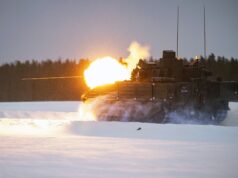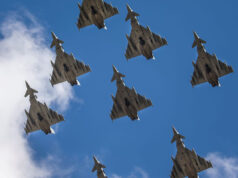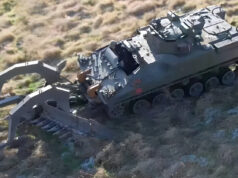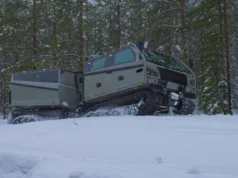A breakthrough in technology for the British Army took place on Salisbury Plain recently, where a demonstration of multiple Unmanned Aerial Systems (UAS) took place.
According to the British Army, funded by Army Headquarters, the nano-Unmanned Aerial Systems project completed a live multiple drone demonstration also known as ‘swarming drones’, pushing technological boundaries.
Lieutenant Colonel Arthur Dawe, Commanding Officer, Infantry Trials and Development Unit (ITDU) explained in an Army press release:
“The stand-out feature of this event is that you are seeing a military operator control more than one drone at the same time from one single unit. This is adding scale and adding complexity with each drone able to carry out a separate task.This is a real amplifier, adding capacity, force protection, intelligence, surveillance and reconnaissance capabilities. The intent going forward is to add a precision strike capability; this will not only assist in our targeting but also in our strike capability, therefore making us more lethal at range which will protect our very valuable forces and people.”
According to the aforementioned release:
“The event was also ground-breaking in terms of the regulatory environment too, as it was the first time the Military Aviation Authority has issued a categorisation of this type for a swarm to be operated by one operator, a huge achievement for the Army and hopefully paving the way for systems like this to come into service. Two different UAS systems were used; the first was the Atlas, where one operator controls four drones on a tablet via individual manual mission taskings. The second system was the Elbit, where one operator tasks six drones, creating autonomous missions. This means the operator can task up to six drones in a fleet on the same mission or various other missions to complete different tasks.
The focus was on two showcase ideas; the first consisted of multiple drones providing a 24-hour perimeter defensive posture, with surveillance provided by multiple UAS in and around a specific location. The second scenario worked on artificial intelligence communicating with the system to plan UAS missions, so that they can provide overwatch and inform the user of any points of interest and following where necessary.”
You can read more here.












Ha from swarming Dervishes and Zulus to swarming drones! What next!?
I thought it was swirling Dervishes
Surely it’s whirling. PS i’m not calling you Shirley ! 😁😁
Either way you can bet they won’t like them up em.
A bit of poetic licence James😂
These are Latvian Atlas tricopters, and Israeli Elbit quadcopters.
According to Janes, the AtlasPRO is approximately 50 cm in diameter and weighs 1.7 kg including battery and payload. The aircraft enables fully- and semi-autonomous missions with 50 minute flight time and 10 km range.
It was reported in Spring this year Elbit would be delivering 5 sets of 6 swarming quadcopters to the Army, but details were a bit thin on the ground. Nice to know they have arrived safely.
Science fact.
I hope the Army are analysing the use that the Ukrainians are making of drones in their war with Russia. Everybody seems impressed with the Turkish Bayraktar armed drones. Dare I suggest that we should be buying, say 25 of them off the shelf? People with experience of Playstations, Xbox etc could be recruited to flly them
We’d be better off partnering with Bayraktar on the twin-engined Kizilelma (MIUS C), trialling the new Rolls Royce Orpheus engines. A Vixen contenter for the carriers as well as being useful to the Army.
Yes, thats a very good idea. But as the MoD are managing the projects they will certainly come in over budget, years late and gold-plated. Buying combat-proven Bayraktars off the shelf means we could get three times as many for half the cost
The MoD won’t drive the speed on the MIUS program; Erdogan will (possibly personally). They are scheduled for deployment on the Anadolu, and the new Ukrainian engines might be the primary hold up.
Sure we could get lots of TB2s, but they aren’t all that good. What was impressive about them was how badly Russian counteracted them at the start of the war. Good for trialling Army CONOPS perhaps (and there’s a lot to be said for that), but they are already out of date for a real war.
What has been shown as vital in the use of drones is doing so in an environment covered by HARM like anti radar missiles. The two working together are mutually complimentary the drone forces the air defence to reveal itself ( without risking manned aircraft) which the missiles can then destroy. In destroying the air defence radars they make the environment safer for both the drones and manned aircraft. Even sophisticated drones are likely very vulnerable in such an un-cleansed environments. indeed the US seem to be accepting their top end drones may not be viable.
Has the UK ordered Spear-EW yet?
Please bear in mind that the TB2’s only had such a good run, mainly due to the ineptitude of the Russian forces to set up a multi-layered air defence network to cover ground movements in the first 3 to 4 months of the conflict. The old Predators we had would have had it just as easy, possible better, as they could launch Hellfire from a longer stand-off distance.
The TB2s don’t have such an easy life of late, as the Russians learnt the lesson the hard way and are now using integrated air defence networks.
As opposed to disintegrated air defences? Which I though were the Russian speciality!
I’ve the point about the TB2 not being all that special.
If this war proves anything it is how on a battlefield old stand alone tech is useless against state of the art integrated systems.
Perhaps the TB2 drone is ‘cheap and cheerful’ but has worked well up to now. Not surprised the Russians are now wary of drones and countering them with integrated air defence.
True but there have been a noticeable uptick in TB2s videos since the Ukrainians were giving HARM missiles. Puts the Russian SAM units in a real pickle. Radiate and get a HARM up your bum or try to hide and watch some drone dropping munitions on your comrades heads.
I am going to be brutally honest. If the Mig 29s and Su27s were fitted with a Western 1553 mission computer, avionics and weapons bus. They would tear the Russian Air Defence network to pieces. This is because you can then use the full potential of HARM. Rather than the current let loose and hunt, which can be a bit hit and miss.
The massive problem that even modern Russian air defence systems have is their radar. The vast majority are either old fashioned Pulse-Doppler mechanically scanned or passive electronically scanned array (PESA) radars. This means their operating bandwidth, i.e. the base frequency range they transmit on is very narrow or fixed and switched in predicable steps.
This makes it horrendously easy to detect the radar using radar warning receivers (RWR) or electronic surveillance monitoring (ESM) equipment. Then get your HARM to follow and track it. If they had active electronically scanned array (AESA) radar it would be different and much more difficult to detect and track.
I won’t give too much detail away, except suffice to say, when the HARM is linked to the aircraft’s mission computer and ESM/RWR, you have a lot more options. Especially when the radar is transmitting intermittently as you can work out the radar’s position, monitor it for movement, then send HARM on its way, when the position is fixed.
Even if the RAF had kept its old ALARM going, these would have ripped the Russian air defence and search radars to pieces. As technology wise, Russia haven’t developed as far as the West.
For the country that held itself up as the second best military, Russia has turned out to be a paper tiger to a degree no one expected. In a conventional fight, nato would have destroyed this lot in a week.
But you do t really need a radar seeking missile.
The place can find the radar and send the location to the missile dynamically or you can use data from the 135.
So whilst radar/emission seeking missile are fire and forget(ish) I don’t see them as being the sole solution and multi purpose munitions can do the job too.
Yes, up to a point. For fixed radar sites, having a RC135 or other assets triangulating the site’s position is relatively easy. Especially when this can be married up to satellite surveillance images. A stand-off missile would make short work of the grid coordinate.
The problem is mobile missile systems. If they are operating behind the lines and changing position every few hours/days. It makes it harder for something like a RC135 to tie down. Unless they can record a pattern of life, but that would take a number of days to record. Plus, a rather stupid radar operator. Which we may not have the luxury of.
For mobile systems, the best way to deal with them is a loitering munition. Israel produced the Harpy for this very mission. With an 8-hour endurance, blast fragmentary warhead and a sensitive RF analyser. It has been used to great effect in Syria and over Armenia. However, I would suggest it may struggle against more frequency agile radars, such as AESAs.
If a Harpy type loitering munition had a second sensor, that could be used to search the ground, after it has got a sniff of a radar emission. Such as Brimstone’s millimetric radar. This would give it the advantage of being able to hunt out the mobile radar when it is not transmitting. It would need to some pretty decent software to allow it to discriminate between the mobile radar truck target and a normal truck. But I believe it is doable, though it won’t be cheap. Think of marrying Spear-3 with the EW version cheap. They have sort of done this with the latest version of HARM.
The US, especially the Navy, carry HARM on strike packages as a reactive weapon, in conjunction with Growler. It’s a “if I’m locked up by an enemy radar”, firing a HARM at it will not only get their attention, but may also break missile lock. One of the problems with the old HARM was it topped out just under Mach 2. Which is now being addressed with the AARGM-ER, which is closer to Mach 4. For a reactive missile speed is everything. Which is one of the reasons why the RAF were investigating using Meteor in an anti-radiation capacity.
The coordinates can be dynamically updated from another platform?
I think we can see that a lot of the Russian operators are unbelievably badly trained or just stupid.
Well interestingly, and it has been noted by some military experts the use of HARM has very much eased their working environment again of late. As usual in the use of technology the balance changes and very often combinations of tech and tactics can restore or alter the balance. I think the biggest lesson will be to work on tools and tech and tactics to make sure the vital work of drones can be carried out and what drones or combination are best suited to then do that job.
This is one concept being discussed to defeat air defences.
https://www.popularmechanics.com/military/aviation/a40899974/air-force-undead-aircraft/
But probably not use them. It’s not so easy as people believe.
Whenever I hear that carriers are unsinkable, I always know that they are not. Then think of drone attacks, a 100, a 1,000, 10,000,
The issue is range and control. If a carrier is sat 100 miles off your coast then you will need a big drone to get to it. You will also need to control it at some point. RF is jammable especially in the frequency ranges most use. Drones are detectable and can be shot down using phalanx (eventually Dragonfire). The atlas drone detailed above has a 30 min endurance at 33 mph . Sit 100 miles off the coast and it wont even reach you. Even with a bigger drone and a higher approach speed, once detected a vessel could up revs to 30knts and avoid most if not all of them.
If they are autonomous then they are more of a cheap mans cruise missile reliant on their own sensors and pre programmed target info. Again finding and attacking the target is the issue being a range Vs speed equation.
Warships in the deep blue briny are going to be more worried about ASMs than drones or loitering munitions for a while yet. In the brown water littoral it could be an issue
US destroyers were buzzed by drones in 2019.
https://www.thedrive.com/the-war-zone/navy-releases-videos-from-mysterious-drone-swarms-around-warships-off-california
I believe they were something like 60 miles from the coast.
Nano drone swarms are going to be a very interesting force in how infantry fight in the future. Affectively having large numbers of essentially disposable eyes and Sensors will mean the infantry that don’t have this will be significantly disadvantaged.
The question is what is the miltiary usage for them. We have already seen civilian drones flying coordinated in their hundreds, but they are always small drones, which in turn only have short range.
Well it comes down to what can they do for the army that can’t be done just now. Also what tasks can the drones do easier and quicker than the current way of doing it.
Really you could have a swarm of drones round every solider alerting them to potential issues all around. Another carrying the some of the soldiers load, more doing resupply, some up higher giving a bigger picture, others ready to drop weapons on targets, the possibilities are endless.
Really comes down to what is the most useful and best value for money first. Also is the tech available now or does it need a load of development.
The issue I have is there is a lot of potential, but not a lot of actual delivery. The tech just doesn’t seem there yet.
The only use I can see for a swam of small drones would be Ukraine style grenade attack on a dug in position. But even small drones still need to be carried and add weight.
Steve, I have seen swarming drones for some years now at displays, so why do you think the tech is not there yet?
They can be carried in vehicles, so they need not load down the dismounted soldier.
Its one thing creating a pretty display, it’s another having a military application. Its the application that I am struggling to see. For large drones I can see it as a way of breaking through air defenses but smaller ones I am struggling to see the answer to the what do they bring question.
Small man portable drones are great for scouting ahead, peeking round corners, on top of buildings etc.
Ukraine has really shown how ruin a vehicles day by dropping a small bomb through the hatch.
It’s the area between handheld drones and predator size things that has great potential. What that will be, we will have to wait for the boffins to work it out
Yeah as single units they can be great for situational awareness or as longer range grenade launchers, but swarms I can’t see the point of.
One more thing for drone defence really a gun that has shells able drones would be great. The longer the range the bigger the shell.
1 shell – 1 drone kill. Programmable shells.
That along with cheap missiles and the tv aerial guns (block the signal) should be a good mix.
I was wondering could british bombing drones have fighter escort drones on say when attacking enemy well garded targets ie airbases or ammunition stores
Steve, The tech is there for (small) swarming drones with some sort of payload, but I agree that the military application is undefined; I certainly can’t think of one.
Still it fits with the opinion of that great military expert, Dominic Cummings, who thought the army could be savagely cut yet again so long as they had some extra drones and cyber gadgets to ‘compensate’.